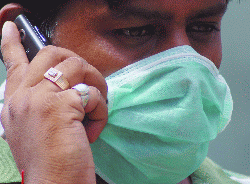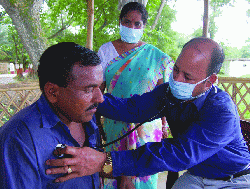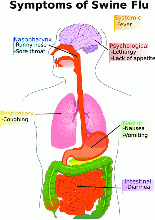Archives
Swine flu- the Pandemic
WHAT IS SWINE FLU?
Swine influenza (also called swine flu, hog flu, and pig flu) is an infection by any one of several types of swine influenza viruses. Swine influenza virus (SIV) is any strain of the influenza family of viruses that is endemic in pigs.
The 2009 flu pandemic is a global outbreak of a new strain of an influenza A virus subtype H1N1, referred to as the ‘novel H1N1’ first identified in April 2009, and commonly called ‘swine flu’. It is thought to be a re-assortment of four known strains of influenza A virus: one endemic in (normally infecting) humans, one endemic in birds, and two endemic in pigs (swine). Transmission of the new strain is human-to-human.
The outbreak began in Mexico. In early June, the virus spread globally; and has since spread to the Southern Hemisphere which entered its winter flu season.
The virus typically spreads from coughs and sneezes or by touching contaminated surfaces and then touching  the nose or mouth. The common places where it affects can be seen in the adjoining diagram.
the nose or mouth. The common places where it affects can be seen in the adjoining diagram.
HOW DOES THE FLU SPREAD
• Spread of this swine influenza A (H1N1) virus is thought to be happening in the same way that seasonal flu spreads.
• Flu viruses are spread mainly from person to person through the coughing or sneezing of people with influenza.
• Sometimes people may become infected by touching something with live flu viruses on it and then touching their mouth or nose.
TREATMENT AND CURE
The Indian Health Ministry has confirmed what doctors have been saying about early reporting and early detection of the disease. Some doctors say that traditional Indian herbs can help in preventing this virus’ attacks. If a person becomes infected with swine flu, anti - viral drugs can make the illness milder and make the patient feel better. As soon as the symptoms are detected, anti - viral drugs should be started. However there is no outright cure for swine flu but the medication Oseltamivir, commonly known as “Tamiflu” has been proved to rid the disease in every case.
Experts from the field of Ayurveda have pointed out that Tulsi is a medicinal plant of Indian origin that has abundant medicinal benefits. Tulsi has much of a cultural significance in India as well, where it is considered divine and its presence in households, auspicious. It is said that Tulsi helps in countering the deadly H1Ni virus. Tulsi is found to improve the body’s defence mechanism against viruses in general and its effectiveness has been vouched for in its ability to act against the virus causing flu.
Shri Ravi Shankar, founder of the ‘Art of Living’ said, “India has a wealth of knowledge from Ayurveda to counter swine flu.”
SWINE FLU IN THE NORTH EAST
| Arunachal Pradesh | Not hit |
| Sikkim | 3 suspected cases all tested negative for swine flu |
| Assam | 3 cases |
| Meghalaya | 4 cases |
| Nagaland | No reported cases so far |
| Manipur | 3 cases |
| Mizoram | 2 cases both cured |
| Tripura | 1 suspected case |
Continued
-
 Swine flu has struck a majority of the Indian states. In the Northeastern part of the country Swine flu has managed to create widespread panic mostly in the urban areas. However the severity of the pandemic can not be ruled out as the winter season is yet to hit the Northern Hemisphere which favours the flu virus. Luckily, three states of the North East have not yet reported any confirmed cases of the flu namely Arunachal Pradesh, Sikkim and Nagaland. Until the filing of this report one suspected case of the flu was reported in Tripura; however, confirmation of the same is being apprehensively awaited. A major section of the people is living in a grip of fear and has stopped venturing out into crowded places. This is a kind of impromptu precautionary measure that they have taken up but how that they have taken up but how long can the people believe in their immune system before they take logical precautionary measures? Good hygiene is of the essence and nothing can beat that. Interestingly, it may be appropriate here to know that 960 people die daily due to tuberculosis while 6301 people die of issues related to the heart; 2740 people die daily due to diabetes and 290 people die due to tobacco related diseases. (The mentioned figures are for India only)
Swine flu has struck a majority of the Indian states. In the Northeastern part of the country Swine flu has managed to create widespread panic mostly in the urban areas. However the severity of the pandemic can not be ruled out as the winter season is yet to hit the Northern Hemisphere which favours the flu virus. Luckily, three states of the North East have not yet reported any confirmed cases of the flu namely Arunachal Pradesh, Sikkim and Nagaland. Until the filing of this report one suspected case of the flu was reported in Tripura; however, confirmation of the same is being apprehensively awaited. A major section of the people is living in a grip of fear and has stopped venturing out into crowded places. This is a kind of impromptu precautionary measure that they have taken up but how that they have taken up but how long can the people believe in their immune system before they take logical precautionary measures? Good hygiene is of the essence and nothing can beat that. Interestingly, it may be appropriate here to know that 960 people die daily due to tuberculosis while 6301 people die of issues related to the heart; 2740 people die daily due to diabetes and 290 people die due to tobacco related diseases. (The mentioned figures are for India only)  The fear is so prevalent and widespread that the major pork eating population of the region has shunned the consumption of the delicacy to such an extent that many pork sellers have shifted to the sale of beef or have closed their establishments until the situation returns to normal. It is worth mentioning here that consumption of well cooked pork will not pass any swine flu as the virus will be eliminated from the cooked meat by the high temperatures it has to face during the cooking process.
The fear is so prevalent and widespread that the major pork eating population of the region has shunned the consumption of the delicacy to such an extent that many pork sellers have shifted to the sale of beef or have closed their establishments until the situation returns to normal. It is worth mentioning here that consumption of well cooked pork will not pass any swine flu as the virus will be eliminated from the cooked meat by the high temperatures it has to face during the cooking process. In India out of the total of 3095 cases identified, 79 people have died i.e. 1 in 39 persons suffering from the disease have succumbed to it. Albeit, the saying ‘precaution is better then cure’ is apt here as a good diet, better health care and a little effort by the general public can help stamp the authority of humans on the H1N1 virus rather then over stressing and letting the panic grip oneself, a little practicality and half the battle is already won.
Some major Killers
1. Plague of Athens, 430 BC. Typhoid fever killed a quarter of the Athenian troops, and a quarter of the population in over four years.
2. Plague of Justinian, from 541 to 750, was the first recorded outbreak of the bubonic plague. The plague went on to eliminate a quarter to a half of the human population that it struck throughout the known world.
3. The Black Death started in the 1300s. The total number of deaths worldwide is estimated at 75 million people.
4. The ‘Spanish flu’, 1918–1919. First identified early in March 1918 in US troops training at Camp Funston; Kansas. By October 1918, it had spread to become a world-wide pandemic on all continents, and eventually infected an estimated one third of the world’s population.
5. The ‘Asiatic Flu’, 1889–1890. About 1 million people died in this pandemic.
6. Fifth pandemic 1881-1896. The 1883-1887 epidemic claimed 250,000 lives in Europe and at least 50,000 in Americas. Cholera claimed 267,890 lives in Russia (1892) 120,000 in Spain; 90,000 in Japan and 60,000 in Persia.
7. During the Thirty Years’ War (1618–1648), an estimated 8 million Germans were wiped out by bubonic plague and typhus fever.
8. Smallpox killed an estimated 400,000 Europeans per year during the closing years of the 18th century.
9. Measles has been estimated to have killed about 200 million people worldwide in the last 150 years.
10. During the 20th century, tuberculosis killed approximately 100 million people.
11. Each year, there are approximately 350–500 million cases of malaria.
12. Approximately 300,000 people are believed to have died from yellow fever in Spain during the 19th century.
Harsh Jhunjhunwala


